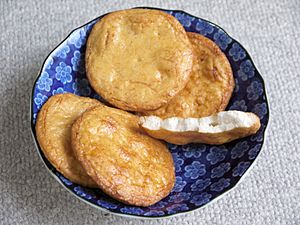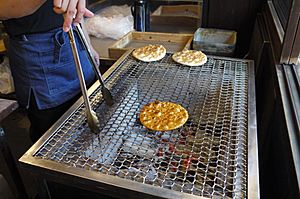Senbei facts for kids

Standard senbei and a cross section view
|
|
| Alternative names | Sembei |
|---|---|
| Type | Rice cracker |
| Place of origin | Japan |
| Region or state | East Asia |
| Main ingredients | Japanese rice (uruchimai) |
Senbei (煎餅, alternatively spelled sembei) are a popular type of rice cracker from Japan. These tasty snacks come in many different shapes, sizes, and flavors. While most senbei are savory, some are sweet. People in Japan often enjoy senbei with green tea as a quick snack. They are also offered to guests as a polite welcome.
Contents
What are Senbei?
Senbei are usually made by baking or grilling them. Traditionally, this was done over hot charcoal. While they are cooking, a special sauce is often brushed onto them. This sauce is usually made from soy sauce and mirin, which is a type of sweet rice wine. Sometimes, a piece of nori (seaweed) is wrapped around the senbei after it's cooked. Other times, they are simply flavored with salt or a "salad" seasoning.
How are Senbei Different from Chinese Jianbing?
The Chinese characters used to write senbei are also used in China. There, they are read as jianbing. However, jianbing is a completely different food! It's a type of crepe that is more like a Japanese okonomiyaki.
In Japan, senbei are hard and crunchy snacks. They are usually small enough to eat in a few bites. In China today, you can find crackers that are similar to Japanese senbei. Their modern Chinese name, xiānbèi, sounds like the Japanese word "senbei."
The History of Senbei
Sweet senbei first arrived in Japan a very long time ago, during the Tang Dynasty in China. The first time they were mentioned was in the year 737 AD. These early sweet senbei were often baked in the Kansai region of Japan. They were made with ingredients like potato, wheat flour, or glutinous rice. They were quite different from the crunchy senbei we know today, being more like soft cakes such as castella. You can still find some traditional sweet senbei today, like Iga meibutsu katayaki.
How Salty Senbei Became Popular
The salty, soy sauce-flavored senbei that most Japanese people think of today became popular later. This happened during the Edo period in a city called Sōka. A teahouse there started making and selling them. From Sōka, these delicious salty senbei spread all over Japan.
Types of Senbei
There are many different kinds of traditional Japanese senbei. They can be baked or deep-fried. Some are sweet, while others are savory. While most senbei are made from rice, some use wheat flour or starch.
Interestingly, some senbei are not even made from grains! For example, there's sakana senbei (fish senbei), renkon senbei (lotus root senbei), and hone senbei (bone senbei).
Modern Senbei Flavors
Today, senbei makers are very creative! You can find modern senbei with all sorts of interesting flavors. These can range from spicy kimchi or wasabi to rich curry or even chocolate.
Regional Differences in Senbei
Senbei from the Kansai region tend to use glutinous rice. They are usually lightly seasoned and have a delicate, crispy texture. People describe this texture as saku saku.
On the other hand, senbei from the Kantō region were originally made from uruchimai, which is a non-glutinous rice. These senbei are often crunchier, described as kari kari, and have a richer flavor.
Thin Japanese rice crackers, called usuyaki senbei, are also popular in other countries like Australia.
Common Senbei Variations
Senbei have several popular variations:
- Nori-wrapped senbei: These have a piece of seaweed wrapped around them.
- Arare: These are very small, bite-sized rice crackers.
- Olive no Hana: A specific brand or type of senbei.
- Soy nut senbei: These include soy nuts.
- Wet senbei: These are softer and chewier than typical crunchy senbei.
See also
 In Spanish: Senbei para niños
In Spanish: Senbei para niños


